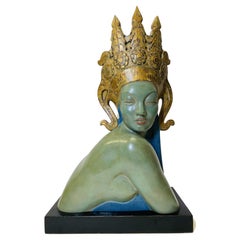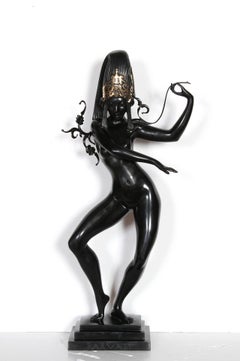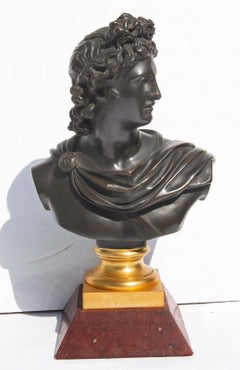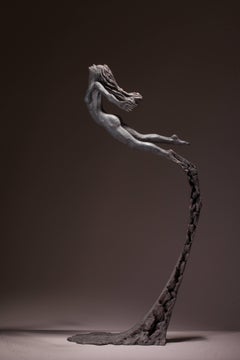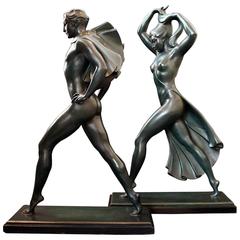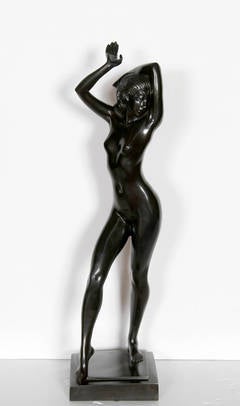Allan Clark Art
to
2
2
2
2
Allan Clark, the King's Temptress, Carved and Polychromed Mahogany, ca. 1926/27
By Allan Clark
Located in New York, NY
ABOUT SCULPTURE
This unusual colorful sculpture depicts a very beautiful Balinese woman with a dance crown on her head, looking straight at the viewer....
Category
1920s American Art Deco Vintage Allan Clark Art
Materials
Mahogany
Parvati
By Allan Clark
Located in Long Island City, NY
A bronze sculpture by Allan Clark originally casted in 1927. A nude figure sculpture of Parvati, the Hindu goddess of love.
Artist: Allan Clark (after), American (1896 - 1950)
T...
Category
1920s Romantic Allan Clark Art
Materials
Bronze
Related Items
Bronze Bust of Apollo Belvedere Grand Tour 19th Century
Located in Rochester, NY
Superb 19th century bronze and gilt bronze bust of the god Belvedere Apollo. Circa 1850. This wonderful grand tour bust is a marvel of refined beauty and elegance, crafted with richl...
Category
19th Century Allan Clark Art
Materials
Marble, Bronze
Ian Edwards - Leap Within Faith - Original Signed Bronze Sculpure
By Ian Edwards
Located in Collonge Bellerive, Geneve, CH
Ian Edwards - Leap Within Faith - Original Signed Bronze Sculpure
Dimensions: 170 x 55 x 40 cm
Edition of 12
Edwards’ practice expresses the power and determination of human endea...
Category
2010s Contemporary Allan Clark Art
Materials
Bronze
H 66.93 in W 21.66 in D 15.75 in
Polychrome carved wood Virgin and Child from the 15th Century
Located in Saint-Ouen, FR
POLYCHROME CARVED WOOD VIRGIN AND CHILD FROM THE 15TH CENTURY
ORIGIN: SOUTH GERMANY, SWABIA, NUREMBERG REGION
PERIOD: 15th CENTURY
Height: 94,6cm
Width : 28 cm
Depth : 18 cm
Lime wood
Original Polychromy
Good state of conservation
From 1430 onwards, sculpture underwent a profound stylistic renewal which continued until 1530, the so-called late Gothic period. In the Germanic countries, original sculptures flourished in an expressive and sensitive vein.
This renewal was inspired by the art of Nicholas of Leiden, who was active in Strasbourg in the 1460's. His style broke with the refined and delicate art of the international Gothic style in force throughout Europe around 1400. The figures became more authentic and realistic. The bodies became denser. Clothes are animated by deep, broken folds, the fabrics are heavy and have a great decorative value. In addition, the polychromy is intended to be illusionistic. The painting makes it possible to restore the texture of the materials, the richness of the textiles and the natural skin tone of the characters.
The dissemination of images through engraving and the great mobility of the artists led to the success of this style, which conquered the Upper Rhine, Swabian, Tyrolean and Franconian regions, contributing to the formation of a common stylistic identity in these regions. The economic boom in the flourishing German cities was conducive to the development of original production. Attracted by this prosperity, numerous workshops were set up in order to meet the orders of religious communities, the Church and the laity, including a clientele of middle-class rockers.
This precious Virgin and Child is depicted standing on a crescent moon, her head encircled by a crown of tall flowers. Her long wavy hair spreads over her shoulders, framing her beautiful oval face. Under fine eyebrows drawn with a brushstroke, her almond-shaped, slightly drooping eyes look at the Child with infinite softness. She is dressed in a long red dress with a rounded neckline, belted under the chest. The heavy fabric of her dress spreads out in broken folds at her feet. On her shoulders she wears a golden cloak. The drapery has deep folds. She holds out her right hand while she holds the Christ Child with her left.
Christ, with his well-defined hair, is naked. His cheeks are highlighted with red, he holds an apple in his left hand and with the other hand makes a sign of blessing towards the faithful.
Virgins with Child on a crescent moon were very popular in the second half of the 15th century, especially as the central subject of altarpieces in southern Germany and Austria. The crescent moon on which Mary is standing is reminiscent of the Woman of the Apocalypse. Often equated with the Virgin Mary.
This episode is taken from the Book of Revelation (12:1-6)
1 Then a great sign appeared in heaven: a woman clothed with the sun, with the moon under her feet and a crown of twelve stars on her head. ; 2 She was pregnant, and she cried out because she was in labor, in pain from giving birth. ; 3 Then another sign appeared in heaven: it was a great fiery red dragon, with seven heads and ten horns, and seven royal crowns on his heads. ; 4 His tail swept down a third of heaven's stars and threw them to the earth. The dragon stood in front of the woman who was about to give birth so that when she gave birth, he might devour her child. ; 5 She gave birth to a son, a male child who is to rule all the nations with an iron rod. Her child was snatched up to God and his throne. ; 6 Then the woman fled into the desert, where God has prepared a place for her. There she will be taken care of for one thousand two hundred sixty days.
Some theologians see in this woman a reference to the Virgin Mary and in the child, Jesus.
This remarkable work is a very fine example of sculpture from Swabian workshops in the last decades of the 15th century. It presents all the characteristic stylistic elements: a highly girdled silhouette, an abundant drapery with angular folds, but also a great physical presence accentuated by the polychromy that restores the anatomical details. This group is made of a wooden log. The deep folds of the drapery highlight the movement of the Virgin holding the child.
Bibliography :
Sophie Guillot de Suduiraut, Dévotion et Séduction, Sculptures souabes des musées de France, vers 1460-1530, Paris musée du Louvre-Éditions somogy, 2015
“Revelation 12 - Common English Bible...
Category
15th Century and Earlier German Gothic Antique Allan Clark Art
Materials
Wood
Carved Wood Polychrome Virgin Mary Statue
Located in New York, NY
Exquisite and compelling wood statue of the Virgin Mary with polychrome paint finish. Well executed, and finely carved we believe it's 19th C Continental, or possibly US in origin. U...
Category
19th Century Spanish Folk Art Antique Allan Clark Art
Materials
Wood, Paint
"At Last, " Sculpture
By Bill Starke
Located in Denver, CO
Bill Starke's "At Last" is a limited edition, bronze sculpture created by Bill Starke depicting a male figure with out-stretched arms.
( 3/85 )
About the artist:
Human beings int...
Category
2010s Realist Allan Clark Art
Materials
Marble, Bronze
Cherub Carved from Wood with Polychrome & Gilt
Located in Chicago, IL
An Italian cherub, carved from linden wood wood. This graceful and exceptionally well-carved figure was likely part of an altar ensemble. The eyes and face are particularly well-form...
Category
Mid-18th Century Italian Baroque Antique Allan Clark Art
Materials
Wood
NYDIA, THE BLIND FLOWER GIRL OF POMPEII Marble Sculpture 1856-1870
Located in Soquel, CA
Randolph John Rogers (American, 1825 - 1892) Randolph Rogers' Nydia, the Blind Flower Girl of Pompeii debuted in 1856 to critical and public acclaim, solidifying Rogers’ position as a pre-eminent American sculptor and it remains one of the artist’s most celebrated works today. The subject of Nydia is drawn from Edward Bulwer-Lytton's The Last Days of Pompeii 1834. After touring the ruins of the ancient city in 1833, and inspired by the stories of blinding volcanic ash, he composed the tale of Nydia, a slave who led her master, Glaucus, to safety. Rogers depicts Nydia at the moment that she and Glaucus have become separated in their perilous journey through the rubble and Nydia seeks familiarity in the surrounding chaos, her distress evident in her pained expression. The grace of the sculpture is at odds with the turmoil portrayed; a toppled Corinthian capital lies at her feet and obstructs her next step, indicated by the tilt of her back foot and grip on her walking stick. Examples of this model can be found in major American collections, including The Metropolitan Museum of Art, the Art Institute of Chicago, the Detroit Institute of Arts, the Los Angeles County Museum of Art, and the Museum of Fine Arts, Boston.
Literature, Millard F Rogers, Jr. Randolph Rogers, American Sculptor in Rome. University of Massachusetts Press, 1971, American Figurative Sculpture in the Museum of Fine Arts Boston. Museum of Fine Arts, Boston, 1986. Joyce K Schiller. "Nydia, A Forgotten Icon of the Nineteenth Century." Bulletin of the Detroit Institute of Arts,
Born in Waterloo, New York, Randolph John Rogers became an expatriate* sculptor of idealized figures, portraits, and commemorative works in Neo-Classical* and Realist* styles. He worked in clay, plaster, marble and bronze, and lived both in Italy and the United States. He made 167 examples of Nydia in two sizes (varies depending on base height) 36" and 54'.
Rogers was raised in Ann Arbor, Michigan, and as a young man did woodcuts* for the local newspaper, The Michigan Argus, and also worked as a baker's assistant and a dry goods clerk. In 1847, he moved to New York City, where he hoped to find work as an engraver*, but failing to do so, worked in a dry goods store owned by John Steward...
Category
Mid-19th Century Romantic Allan Clark Art
Materials
Marble
Large Carved Polychrome Decorated Stags Head
Located in Cheshire, GB
Large carved wood and polychrome decorated stags head, carved with glass eyes and taxidermy antlers. Mounted on carved back plate.
Dimensions:
Height 48.5 inches
Width 24.5 inches...
Category
Mid-20th Century British Allan Clark Art
Materials
Paint
Statue of Athlete: Large Academic Style Bronze Figurative Sculpture of Nude Male
By Mark Beard
Located in Hudson, NY
modern figurative bronze sculpture of a nude athlete
8.5 feet tall and measures 36 inches at the widest point
bottom base measures ...
Category
Early 2000s Academic Allan Clark Art
Materials
Bronze
H 102 in W 36.5 in D 17.5 in
Antique Hand-Carved Architectural Wooden and White Polychrome Floral Carving
Located in Leesburg, VA
Antique Hand-Carved Architectural Wooden and White Polychrome Floral Carving
Anonymous
Probably South Asia; mid-20th century
Wood
Approximate size: 12.8 x 2.28 x 6.8 in.
A South A...
Category
Mid-20th Century Rustic Allan Clark Art
Materials
Wood
H 6.8 in W 12.8 in D 2.28 in
Male Bust - Bronze Sculpture by Igor Mitoraj - 1991
By Igor Mitoraj
Located in Roma, IT
Amazing male bronze bust with a black patina. This work is the 6th from an edition of eight.
Its creator, Igor Mitoraj, is a polish sculptor deeply rooted in the classical tradition....
Category
1990s Contemporary Allan Clark Art
Materials
Bronze
Hand Carved & Polychrome Folk Art Santo Sculpture
Located in Chicago, IL
Hand carved and painted santo with child, possibly John The Baptist. The vivid polychrome colors and primitive wood carving make for a striking...
Category
20th Century Mexican Folk Art Allan Clark Art
Previously Available Items
Art Deco Sculpture Pair
By Allan Clark
Located in Forest Row, East Sussex
Man and woman, an impressive pair of Art Deco bronze figures by Allan Clark (1896-1950). Dark green patination with stylised features. Set over black marble plinths and stamped Allan...
Category
Mid-20th Century American Art Deco Allan Clark Art
Materials
Bronze
In the Path of the Sun
By Allan Clark
Located in Long Island City, NY
A bronze sculpture by Allan Clark made from an original casting in 1930. A nude figure of a woman in extended contrapposto pose.
Artist: Allan Clark, After, American (1896 - 1950...
Category
1930s Romantic Allan Clark Art
Materials
Bronze
Allan Clark art for sale on 1stDibs.
Find a wide variety of authentic Allan Clark art available for sale on 1stDibs. You can also browse by medium to find art by Allan Clark in bronze, metal and more. Not every interior allows for large Allan Clark art, so small editions measuring 11 inches across are available. Customers who are interested in this artist might also find the work of and Rene Murray. Allan Clark art prices can differ depending upon medium, time period and other attributes. On 1stDibs, the price for these items starts at $18,000 and tops out at $18,000, while the average work can sell for $18,000.
